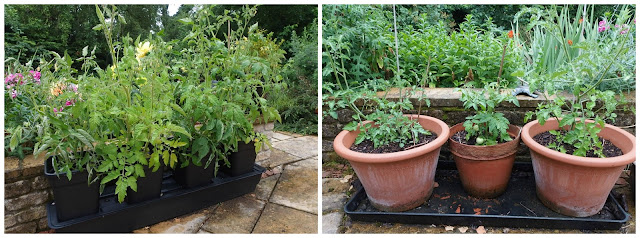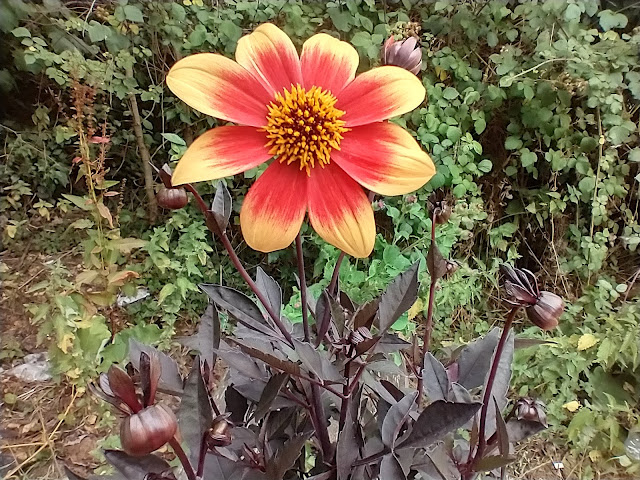Salad Days: A Quick Look at Hydroponics
 |
| Separated at Birth? Hydroponic-ish grown tomatoes (left) vs those grown in containers as usual |
NB These planters strictly speaking aren't hydroponics ones because they're using compost as the growing media: with hydroponics an inert material such as a mineral wool or clay pebbles are used. However, I believe the kit I'm using utilises many of the principles of hydroponics and can be used to explain what this growing method is about.
As you can see the self-watering container on shown on the left (aka Quadgrow) consists of four planters which sit above a large tank of water. Inside, a strip of absorbent material is fed through a hole in the bottom of each planter and the material acts as a wick to transfer the water into the compost. Far less compost is needed than with the usual kind of containers; just enough to hold the plant in place and allow it to take up water and nutrients successfully. So far the above photos show what a difference that can make.
The tomatoes are Gardeners Delight and Black Krim: planted out at the same time with 3 plants going into my usual containers and four into the Quadgrow. Some further points to note:
- Fresh peat-free compost was used for all the pots
- Both sets of plants are next to each other on the sunniest part of the patio (I've reversed their positions above)
- I bought plants on special offer from my local garden centre as I had no room to grow my own from seed and I have a dismal track record in starting my own tomatoes anyway. I needed to start this trial with plants as similar as possible, so I thought it wise to use my Cheat's Guide ;)
- All tomatoes were planted outside at the end of June after the last frosts, though at that time temperatures were still inclined to dip quite a bit at night
- Water has been topped up in the Quadgrow every 10 days and the container tomatoes watered every other day
- I haven't been using the feed supplied with the Quadgrow, nor have I fed the container plants (baaaaad VP!). Note to self: must start feeding them this weekend
 |
| A look under the covers at the roots dangling in the water |
As you can see, the Quadgrow plants are faring much better. As I've not fed them yet, I believe this is down to a couple of factors:
- The black plastic is absorbing the heat and keeping the plants at the kind of temperatures they like for much longer. This was probably particularly important at the beginning when temperatures were dipping into the cool side of things overnight
- Having a constant supply of water at the root zone ensures the plants never go short of water
Here's a quick look at me setting up the Quadgrow back in June, so you can see what's involved:
 |
| Note that the water chamber underneath holds 30 litres of water and is fully covered |
NB The kit I'm testing is marketed for use in a greenhouse. However, it seems to be performing OK outside. I'm not sure how much difference a summer like last year would make to the results though! The water compartment is well covered, but rain would be able to get in via each of the planters and possibly make it overflow.
A few other things I've learnt about self-watering containers and hydroponics
- The Saladgrow I've been using for my windowsill lettuces is another example of a self-watering container. I'll also be trialling another type of self-watering pot I have for my chilli plant later
- Hydroponics is a way of growing plants without using soil. Aquaponics is where fish are added into the system. Their waste is used to feed the plants growing above them. The aquaponics system I saw at the Edible Garden Show costs quite a bit more than the kit I'm testing here
- There are two types of hydroponics - active and passive. The Quadgrow and Saladgrow are using the same principles as a passive hydroponic system where water and nutrients are transferred into the growing medium by capillary action. Active is where a pump is used to constantly wash water and nutrients across the root zone. A simple guide to hydroponics can be found here.
- Active systems usually out perform their passive cousins because the former maximise the availability of oxygen to the plants. However, the use of a pump means there are extra running costs involved with this type of system
- There's also aeroponics, where plant roots are suspended in a misting chamber rather than a growing medium. The misting system delivers a constant supply of oxygen, water and nutrients. This is claimed to deliver the highest yields, but it looks like it's relatively complex compared to hydroponics
- So far I've only found examples of non-organic feeding with this kind of kit. I'm going to start trialling using some shop bought organic feeds to see if these can be used successfully
- There's a lot more to learn and I have yet to visit Bill and Ben ;)
Disclosure: I received various self-watering planters plus a simple active hydroponics system to trial courtesy of the manufacturer. I'm under no obligation to provide a favourable review and I've already given them some ideas to improve the instructions they supply with their kit.










Very interesting!
ReplyDeleteHave a happy week-end!
Lea
Lea's Menagerie
Mississippi, USA
hanks Lea - you too!
DeleteWe planted far too much salad and can't eat it quick enough - its all started going to seed. Hoping to tidy it all up and maybe plant a fresh batch in the next week or two - plenty of growing season left :)
ReplyDeleteAgh - I meant to put a reminder up about sowing some more salad now that the weather's cooler. Must remember next week...
DeleteI wonder if Mr Linky is working - I left a link to my Salad Days post, but it has disappeared. Can you find it, or should I try to link again?
ReplyDeleteLea
Lea's Menagerie
Hi Lea - thanks for letting me know about the problem. Something went wrong with Mr Linky and instead of restoring today's Linky, it opened a new one. I've transferred over yours and the other 2 links which were left on the previous Linky. Have a great weekend!
DeleteGreat post re: those containers. Here, we have Earth Box and Grow Box which are similar in structure. I used one of them last year. I liked it okay, but I tend to like drip irrigation better. Here's why for me, mosquitos. They are such terrible creatures. A lot of folks here also use the mosquito dunks in those type of containers. Just the hot and (this year) wet side of the world. Happy Salad Days VP!~~Dee
ReplyDeleteGood point Dee - I'd be comparing like with like a bit more if my containers had a drip feeder rather than me watering them every couple of days. The water reservoir is fully covered and the growing medium is damp rather than wet, so hopefully that would keep those pesky mosquitoes down to a minimum. We live right by a stream, so I know just how annoying they can be!
Deletewow that sounds very technical but seriously interesting too. I shall give it a try once the garden is under control.
ReplyDeleteHi Catherine, I've been wanting to try hydroponics for a while and this comes pretty close :)
DeleteI'm using quadgrows for the first time this year for my chillis. The growth is unbelievable. I've got plants pushing 8 foot tall covered in pods. Anyone thinking of trying the quadgrow I really recommend it.
ReplyDeletethanks! My hubby likes to grow super hot peppers--jolokia & a new one that is even hotter. I will tell him about this as he loves to make his babies as big as possible. :)
DeleteTai - I did consider using these for chillis, but it sounds like we'd have far more than we could cope with! So far, we're on for a great crop of tomatoes - fingers crossed the warm weather continues!
DeletePokeberry Mary - welcome and thanks for Following :)
Love your post comparing the plants. hydroponic plants were very popular back when I was getting my first apartment--furnished mainly with plants from 'plant parties' I hosted. Era-- 77? We have no shortage of rain this summer, but I'm definitely going to consider doing this next year. :) thanks!
ReplyDeleteToo hot for lettuce so I just sowed a fall crop....
ReplyDeleteMe too Donna!
ReplyDeleteThat's really interesting. When I grew toms in pots in the greenhouse I used a home made automatic watering system inspired by the same system. I used capillary matting in a resevoir, it made looking after them much easier than the ones in grow bags were, even with fancy grow rings. Now I am growing them in beds in the greenhouse which is even easier and they are doing really well, but now you have me wondering if my home grown system would work outside. As for sald, I am about to try a sowing for late summer, but am betting everything will bolt...
ReplyDeleteJanet - if you're growing greenhouse toms, then I think that would be best as they have less risk of getting blight.
ReplyDeleteIt's the ideal time to sow salad now as it's a bit cooler. And it's best to do now so you have some salad well into the autumn/early winter :)